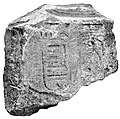Byblian royal inscriptions
The Byblian royal inscriptions are five inscriptions from Byblos written in an early type of Phoenician script, all of which were discovered in the early 20th century.
They constitute the largest corpus of lengthy Phoenician inscriptions from the area of the "Phoenician homeland"; it is the only major site in the region which has been excavated to pre-Hellenistic levels.[1]
The five royal inscriptions
- The Ahiram Sarcophagus (KAI 1), discovered in 1923, together with two fragments of alabaster vases with the name of Ramesses II[2]
- The "Yehimilk of Byblos Inscription" (KAI 4) published in 1930,[3] king "Yehimilk of Byblos"[4]
- The Abiba’l Inscription (KAI 5), on a throne on which s statue of Sheshonq I was placed, found in 1895,[5] published in 1903[6]
- The Osorkon Bust or Eliba'l Inscription (KAI 6), inscribed on a statue of Osorkon I; known since 1881, published in 1925 [7][8]
- The "Safatba'al Inscription" or the "Shipitbaal inscription" (KAI 7), found in Byblos in 1936,[9] published in 1945,[10] king Sibiti Baal of Byblos[4]
KAI 2 is the necropolis graffito and KAI 3 is a bronze spatula; neither contain names of royalty or other historical information.
Gallery
 Osorkon Bust inscription (Phoenician inscription on left and right of cartouche)
Osorkon Bust inscription (Phoenician inscription on left and right of cartouche) Ahiram sarcophagus inscription
Ahiram sarcophagus inscription Abiba’l inscription (Phoenician inscription more clearly visible on the archaeological copy)[lower-alpha 1]
Abiba’l inscription (Phoenician inscription more clearly visible on the archaeological copy)[lower-alpha 1] Yehimilk inscription
Yehimilk inscription Safatba'al inscription
Safatba'al inscription_-_Mus%C3%A9e_national_du_Liban.jpg) Safatba'al inscription
Safatba'al inscription
Bibliography
- Christopher Rollston, "The Dating of the Early Royal Byblian Phoenician Inscriptions: A Response to Benjamin Sass." MAARAV 15 (2008): 57–93.
- Benjamin Mazar, The Phoenician Inscriptions from Byblos and the Evolution of the Phoenician-Hebrew Alphabet, in The Early Biblical Period: Historical Studies (S. Ahituv and B. A. Levine, eds., Jerusalem: IES, 1986 [original publication: l946]): 231–247.
- William F. Albright, The Phoenician Inscriptions of the Tenth Century B.C. from Byblus, JAOS 67 (1947): 153–154.
- Vriezen, Theodoor Christiaan (1951). Palestine Inscriptions. Brill Archive. GGKEY:WGXUQKP9C87.CS1 maint: ref=harv (link)
Notes
- See here
gollark: DON'T!
gollark: Its job is soley to turn on an output if the input is above 14 signal strength.
gollark: It's literally just a comparator and some wiring outside of the TIS, which is in fact acting almost as a 14-block redstone wire but smaller.
gollark: It's modded.
gollark: Vanilla redstone fed into a TIS-3D box.
References
- Doak, Brian R. (26 August 2019). The Oxford Handbook of the Phoenician and Punic Mediterranean. Oxford University Press. p. 224. ISBN 978-0-19-049934-1.
- René Dussaud, Les inscriptions phéniciennes du tombeau d’Ahiram, roi de Byblos, Syria 5 (1924): 135–157.
- Maurice Dunand, Nouvelle Inscription Phénicienne Archaique, RB 39 (1930): 321–331.
- "Middle East Kingdoms- Ancient Central Levant States". Kessler Associates. Retrieved 23 May 2017.
- Vriezen 1951, p. 9.
- Charles Simon Clermont-Ganneau, Inscription égypto-phénicienne de Byblos, Comptes rendu, Académie des inscriptions et belies-lettres (Paris, 1903).
- Vriezen 1951, p. 10.
- René Dussaud, Dédicace dune stame d’Osorkon Ier par Elibaal, roi de Byblos, Syria 6 (1925): 101–117.
- Vriezen 1951, p. 11.
- Maurice Dunand, Biblia Grammata: Documents et Recherches sur le Dévelopment de L'écriture en Phénicie (Beyrouth: Direction des Antiquité, 1945): 146–151.
This article is issued from Wikipedia. The text is licensed under Creative Commons - Attribution - Sharealike. Additional terms may apply for the media files.